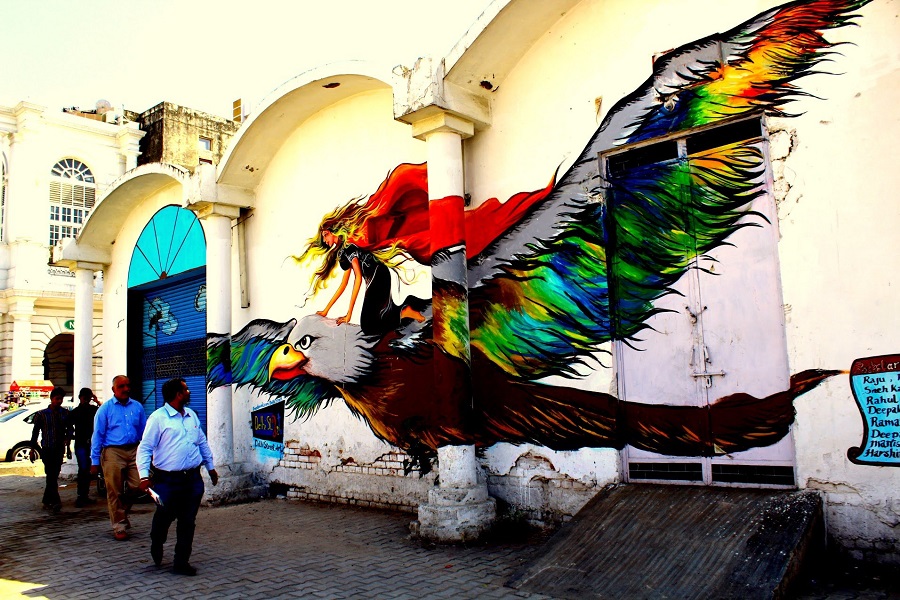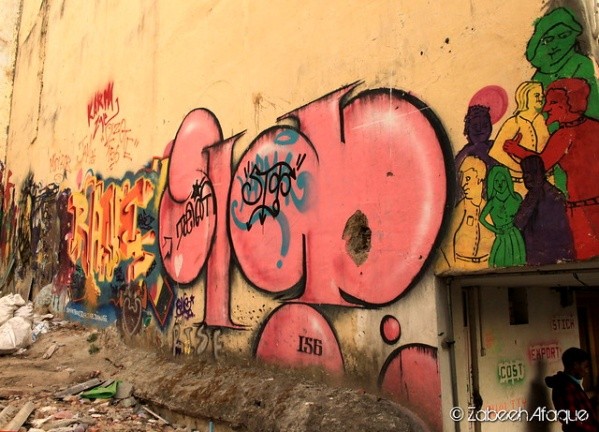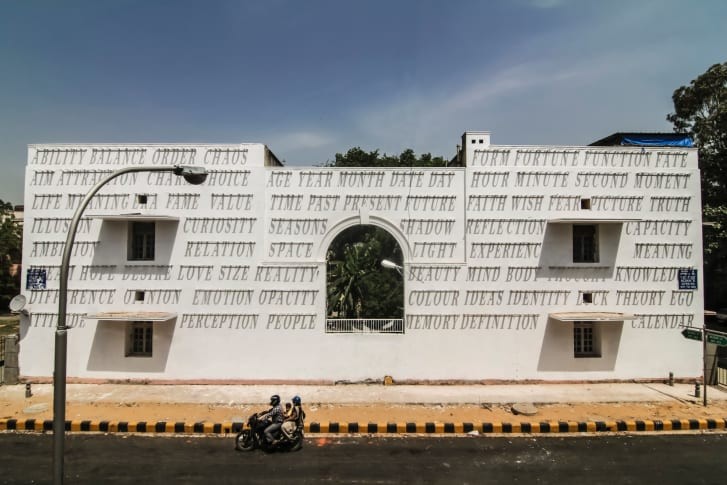This long-read-research article about Street Art- Graffiti in the Indian context brings multi-layer ideas about social life and street art as a context itself.
Kritika Verma
It is a dizzying prospect to account for the wide variety of individuals that make up the audience of urban street art, “the only immediate feedback the artists get is how long [it] stays in place”. It is also naïve to consider the public as one homogenous body. At a local level, various studies in European countries show that “grassroots actors are keen to learn more and to supplement their own intuitive and pragmatic knowledge”.
The primary means of promoting street art and attracting audiences are festivals through companies, but it is challenging to evaluate the demographic makeup of these. From a European perspective, it is “essential to stress that street artists take part in great challenges currently raised at the EU level regarding economics, social issues, the environment and citizens”. However, surveys and interviews conducted in various countries employ different approaches to gathering data. For example, a ‘market research’ approach was adopted in France, which considers “how our cultural practice, our cultural action…on creating a living environment”. In contrast, UK research focuses on public satisfaction, particularly “the economic and social implications of events at the heart of the city”.
Urban street art in some countries gives political recognition, even formulating supportive policies and measures. In contrast, others do not provide political or artistic credit, even though the activity is on the ground. These are just a couple of examples of the variations in approach by national governments to street art, and evidently, there is a need for further research; it is essential to identify its public as this information will provide a valuable tool for furthering recognition and legitimacy.
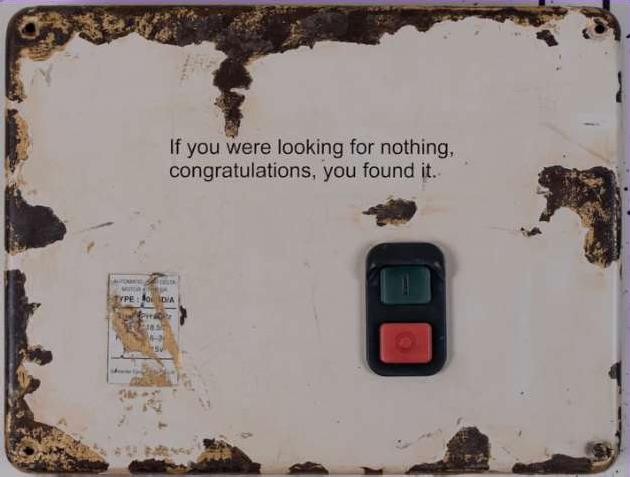
“If You’re Looking For Nothing, Congratulations! You Found It” by Tyler
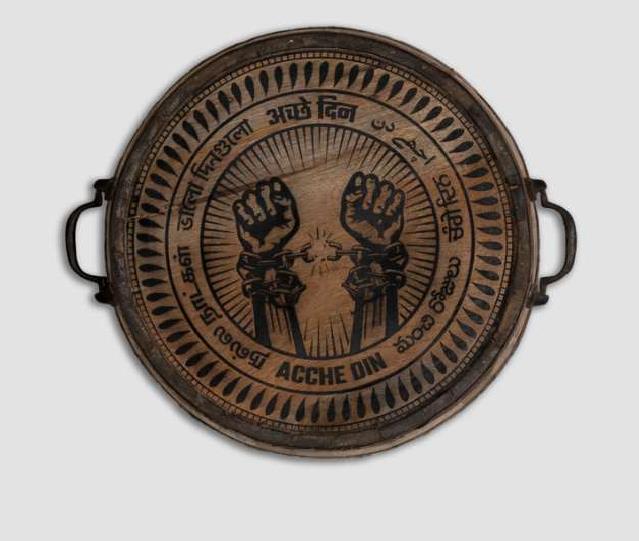
In Delhi, one building now shines. Drilled into a wall gleams with an off-beat piece of art — but only when the sun by local street artist Daku, the black-and-white mural features stylised words cut from semi-metallic sheets.
The new work is designed to reflect life’s changes and rests on an intricate game of light and shadow. When the sun shines overhead, the metallic pieces cast shadows that reveal words. When the sun fades, so does the art.
Season, balance, order
Simple as it may seem, the mural took a lot of planning. “It can get a little technical at times, but I have wanted to do it for two to three years,” says
Daku, which is the Hindi word for thief. His vision was finally realised. Group St+Art Foundation invited him to create his work in one o the art districts.
With the help of simple online application tools like Google Maps and SketchUp, Daku studied the movement of the sun o letters.
“I had to decide the size of the letters, the length of the pieces, and the angle I could place them in so pedestrians could easily see it,” he said. Every word on the mural — season, balance, order, past, present, future — reflects time, motion and change, concepts that Daku often explores in his work.
Shadow art
Best seen at noon, the words drift on the shadows, leaping out one minute and pulling away the next. “You see different words every day. Every day brings a new change,” he explains.
This is not the first time Daku, a fine arts graduate who only wants to be known by his street name, has had his work featured in New Delhi.
A fan of “guerrilla-style art” and typography, he typically uses the city’s walls to make bold statements and says he prefers to work in “illegal spaces.” Although this artwork may steal from the shadows, it’s legally gracing an old building in Delhi’s pedestrian-friendly Lodhi Colony neighbourhood. Just make sure to see it while the sun’s out.
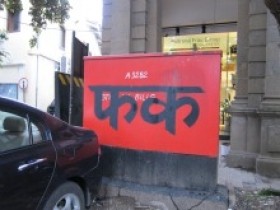
From a small interview with graffiti artist DAKU –
1. How did you get into the trade?
I wanted to be a sign painter. I’m from a small town [where] I got interested in typography. For me, graffiti is a perfect combination of [the work of] an Indian street painter and a modern typographer, and that’s the reason why I started doing it.
2. Why the name Daku?
A daku used to come on horses, rob the trains and villages, and leave. This daku does the same thing but with walls. I take your walls, make them mine and leave. It’s about spreading your tag name; you don’t want to reveal your identity [because] then people relate to you as a person.
3. Why did you use the Devanagari script?
You’ve seen this word in English many times, but I don’t know if you’ve seen it in Hindi before. And it is for those people who don’t speak English. It’s only two letters: ph and k. People can make what they want of it. I asked a taxi guy in Bombay, “Kya Likhahain? ( What is written ?)”. He said, “Patanahin( I don’t know)”. But when I pushed him, he said, “Fuck like Hain. Jab koi Aadmipareshanhotahai, Boltahain ‘Fuck yaar’. (The word “Fuck” is written. When anyone is irritated or tensed, they say “fuck man”)” So the word has multiple meanings for different people.
4. But why the word ‘fuck’ in particular?
I felt people were under pressure because of the whole double tension. And anyway, life in Mumbai is stressful. When driving in a taxi or auto, you’re just looking at the walls, and they’re always trying to sell you something: buy this cream or this shirt. The word ‘fuck’ is also a kind of communication, but not trying to sell you anything. All it’s doing is bringing a smile to your face. That’s it.
5. Few people know your true identity. Why all the secrecy?
What I’m doing is illegal, that’s why. In India, graffiti is banned under the West Bengal Act, which comes from Calcutta. People complained so the law came into the picture, and now you cannot write, paint or use any medium on a wall, lamp post, a tree or anything visible to the public. Slowly, all states in India, apart from a few, adopted the law. According to that, if you get caught, you must pay a fine of Rs1,000 or serve six months in jail. We get fucked when it’s both.
How did you go about spray-painting the ‘fuck’ signs without getting caught? We did it in July, around 11 pm one night. We look at walls as opportunities when we do it in any town. One can easily conquer Bombay in one night. It doesn’t take much if you plan it properly. In the course of one night, I did seven of them, starting from Juhu to Mahim to Lower Parel. I did one on Marine Drive. Then I felt I shouldn’t have done that. I painted it on a flyover in silver, so it was loud, and you could see it from afar. The following day, at 10 am, I got up, went to the paint shop and whited out the ph and only kept the k there.
6. Street art or vandalism? How would you qualify this?
Street art and graffiti, and vandalism are three different things. Graffiti you can associate more with vandalism. Street art is done with permission; graffiti is done without consent. But it’s not vandalism; we don’t invade anyone’s property or hurt anyone’s sentiment by painting on religious places or anyone’s vehicles because we want to keep graffiti as happy as possible. In the West, it has a negative vibe, but here in India, it’s all good.
7. Where else in Mumbai can we see your graffiti?
There’s one ‘Daku’ in Bandra. When you go towards Mahim, there’s a nala with a big pipe— a big ‘Daku’ written about 15 or 20 feet long.
This light-sensitive mural, drilled into a New Delhi wall by Indian street artist ‘Daku’, is designed to change with the sun’s position. Credit: Pranav Gohil
The potential role of environmentally engaged urban street art
This sub-chapter has explored urban street art as a tool for urban discovery. It challenged how cities are experienced, shaped and lived, drawing attention to the power dynamics, interests and social relationships that make up the urban fabric. This raises issues of legality and illegality, the use of space, and questions the practice of everyday life. It calls for creating situations to unmask the spectacle, acting as the social interstice for awareness and change. The argument above observed the relationship between society and urban street art. In this next sub-chapter, a third element is introduced, the environment; here, the idea becomes cyclical, exploring the dynamic relations between the environment, street art and society. Environmental art can be defined as “the production of artistic works intended to enhance or become part of an urban or another outdoor environment; the production of works of art by manipulation of the natural landscape; The production of works of art in the form of large installations or assemblages that surround the observer”. Increasingly, environmental art is crossing over from the exhibition room to the street and back to the galleries.
This fluidity is essential, allowing the art to adapt to, address, and represent society’s constantly changing nature. Indeed, it provides the opportunity to explore environmentalism within these different settings and interact with a broader demographic. As messages of political, economic, environmental, or social discontent are interwoven within contemporary street art, the points of encounter provide a broadening opportunity and diversity to remix mainstream culture, and as Lefebvre pointed out, within the masked spectacle, “It is obviously in the domain of art that this illusion and its consequences may be best observed”.
Considering the previous chapters, how do we now understand ERM as a tool for transformative social change within urban spaces? A meaningful relationship can emerge by placing importance on the role of the consumer or spectator within politics, art and the environment. Indeed, “the critique of everyday life contributes to the art of living […] the art of living implies the end of alienation – and will contribute towards it”. Through the eye of the artist and the spectator, certain relationships within the existing world are revealed, depicting concealed and passive facets of everyday life. Street art can be used to condition ambiences and influence the creation of situations; failing to criticise the everyday “means accepting the prolongation of the present thoroughly rotten forms of culture and politics, forms whose extreme crisis is expressed in increasingly political apathy and neo-illiteracy, especially in the most modern countries”.
In an era of increasing urban spatial growth, it is worth returning to the debates within unitary urbanism, which raises critical approaches to cities and everyday life. The avant-gardism of unitary urbanism explored issues of representation, imagination, participation and pleasure. The creation of situations explores these states of encounter and artistic interest. The interstice becomes a “space in human relations that fit more or less harmoniously and openly in the overall system, but suggests other trading possibilities than those in effect within this system”. ERM is the lens that suggests other possibilities. Of course, encounters vary in association, “Each of us connects differently. The connection runs deep in some; it skips across the surface in others. Sometimes it catches us and pulls us along. Sometimes it changes us completely”. The spectator and the artist are interchangeably the instigator of such revelation and the receiver. Everyday life is remixed as the spectator takes something away from the visual interpretation, transformed from a passive into an active participant. In this way, social transformation is cyclical.
Cities become fluid spaces of possibilities for transformation, “New challenges to unequal power relations emerge in cities around the world, as people re-appropriate and reconstruct urban spaces with the aims of social transformation”. This chapter, therefore, views ERM as a starting point, a door to new understanding and awakenings, jolting the everyday from predictable, blurred generalisation. As a result, it evokes an environmentally conscious transformative social change, instigating a Read/Write Culture that nurtures the creativity of individuals to produce and influence, contributing to the art of living, “In the future, the art of living will become a genuine art, based like all art upon the vital need to expand, and also on a certain number of techniques and areas of knowledge, but which will go beyond its conditions in an attempt to see itself not just as a means but as an end”.
This chapter has sought to exemplify how the street can be more about social interactions, relating to other people, and how street art can challenge our attitudes and practices in everyday life to support sustainable, transformative social change. The environment does not stand alone against political, social or economic issues; our daily reality is woven from these entanglements. ERM reflects this by critiquing everyday life through the social interest it creates and revealing new environmental understandings, raising awareness of surroundings. Additionally, the spectacle only reinforced our alienation from one another, with Debord stating, “The spectacle is the acme of ideology, for in its full flower it exposes and manifests the essence of all ideological systems: the impoverishment, enslavement and negation of real life. Materially, the spectacle is ‘the expression of estrangement, of alienation between man and man’.
It is not merely about raising individual consciousness but collective consciousness as well, with self-emancipation beginning when we emancipate ourselves from “the material bases of inverted truth. This ‘historic mission to establish truth in the world’ can be carried out neither by the isolated individual nor by atomised and manipulated masses, but – only and always – by that class which can affect the dissolution of all classes […] It cannot be carried out, in other words, until individuals are ‘directly bound to universal history’; until the dialogue has taken up arms to impose its conditions upon the world”. In February 2012, an international conference in Berlin called “Radius of Art: Creative Politicisation of the Public Sphere, Cultural Potentials for Social Transformation” discussed the effects of art and culture on socio-ecological transformations towards more sustainable cultures focussing on; art for social change, public art, art towards cultures of sustainability, and cultural policy strategies and funding structures. While the conference observed art under the ‘public art’ umbrella, arguments and conclusions can be applied to ERM. It defined public space as neutral space but recognised that this did not exist in reality, constrained by the influence of consumerism, “Which constantly has to be fought for to be constructed and deconstructed according to the wants and needs of artists and varied audiences”.
They are considered that there were two categories of this art. Firstly, art that dealt with social and political issues, pushing for social interaction, participation in conceptualising by locals, and broadening the range of spectators. Secondly, a hit-and-run guerrilla tactic, more conceptual than aesthetic, merging with everyday life, “creates in-between spaces, un-commercial environments, in which a creative rather process orientated chaos brings people together for positively contributing to the culture of life, of locality and their community”. The projects aimed to strengthen individuals, groups and society, initiating and promoting social or ecological transformations through the potential of art and culture as a catalyst for transformative social change. These cultures “search for conceptual alternatives derived from biological and cultural diversity and enables human welfare”. It found that with a continued lack of definition, recognition for public art was complex, but that it is interdisciplinary, the antithesis of the monoculture, making living conditions better and more beautiful and that the works become a platform for social interaction and activism.
ERM encompasses more than just traditional notions of graffiti; the use of natural mediums, reverse graffiti, sculpture, light installations, and guerrilla gardening, among others. Many artists sensitive to pollution issues have developed street art types that are conscious of their environmental impact and express an ecological message. They are less toxic and hence more appropriate for disseminating their message.
ERM acts as a movement against the process of ‘decomposition’, “in which traditional cultural forms have destroyed them due to the emergence of superior means of controlling nature which make possible and necessary superior cultural constructions”. The legacy of the art, rather than the artist’s role, plays a cultural response to environmental issues. The diversity in ERM reflects artists’ mastery, the mediums and messages they seek to address and their concern over environmental issues. In creating these new points of encounter, ERM has the potential to raise the consciousness and awareness of one’s surroundings, serving as a stark reminder of the natural world’s existence and our effect on it, “this system of intensive encounters has ended up producing linked artistic practices: an art form where the substrate is formed by inter-subjectivity, and which takes being-together as a central theme, the “encounter” between beholder and picture, and the collective elaboration of meaning”. The social interstices created by these environmentally engaged street artists are a reflection of the world around them and their experiences of it. The very act of ERM is political.
It is a counterculture to the homogenous urban society. The artist protests against the “tendency to blur, collapse and erase the distinctions between art, politics and every day”. ERM strengthens the visibility of the environment in the urban context, highlighting its pivotal role as a resource for human activity, “to undercut capitalism’s power…the key step was to begin living a richer, less alienated, more participatory culture… Through a fusion of art into the everyday, people should rediscover their ability to control their own lives”. ERM provides an intense experience within everyday life, “the truth… is that the people do make a choice. If it isn’t right, it disappears. If people love it, it stays”. The détournement of familiar elements into a new ensemble reignites and unifies our affection, values and sensitivity to the world around us. In this way, the spontaneous act of ERM awakens our unconscious reality of how alienated we are from the natural world. There remains a research gap for further analysis of its qualitative and quantitative effects and the extent to which it catalyses change. However, it can no longer be ignored as a growing subculture that takes to the streets and visualises an alternative approach to the world, and as Lefebvre exclaims, “Let everyday life become a work of art! Let every technical means be employed for the transformation of everyday life! From an intellectual point of view, the word ‘creation’ will no longer be restricted to works of art but will signify a self-conscious activity, self-conceiving, reproducing its terms, adapting these terms and its reality”.
Fundamentally, this chapter has explored the accessibility and use of public spaces within our contemporary urban structures. It has also sought to examine the intervention of urban street art and ERM as a playful and colourful way of reconnecting with our environment, ourselves, and communities. By exploring the very act of creating urban street art to that of the arguments of the Situationists, Debord, de Certeau, Lefebvre and others, we see how urban street art becomes the entry point in the everyday urban experience in reawakening our unconscious routine and patterns. To look at the fabric of everyday life through the encounters of ERM is to create new possibilities for an alternative future.
Instead, its audience is an overarching reach of people who use the street, a constantly changing and fluid movement. By existing on the road, it avoids filtering people into a smaller, elite demographic and remains accessible within the public realm. The legacy of urban street art lives momentarily in situ between spectator and urban street art and on a more timeless scale as a memory immortalised within the virtual world. In remaining accessible on these multiple levels, the spectacle continues to be challenged both in situ and online. Combining these two elements within the confusing legal and illegal paradigm means ERM prevents the predictability of becoming another spectacle. As a result, this creates urban street art’s unique ability to change the way we envision our everyday existence. In exploring the possibilities for a Read/Write Culture, ERM is identified as a feedback loop into mainstream culture, closing the connection between artist and spectator, producer and consumer.
Through the act of appropriation and re-appropriation of the dominant images, products, messages, spaces, economy and hierarchical distribution of space experienced in urban environments, ERM transcends the conventional, controlled use of space. Therefore, transformative social change is defined as moving beyond a shift in attitudes towards a change in lifestyle patterns and behaviours. However, there are limitations to the argument provided within this working paper. Primarily, without the spectator’s voice, this chapter remains solely within the theoretical realm, and therefore the success of ERM as a supportive tool in catalysing transformative social change needs further research. While Chapters Three exemplified street art and ERM in practice as a growing subculture through various artists and techniques, it was primarily discussed from the artist’s perspective.
Do they change their routine because of it? How can we understand more fully the role of the active participant? This can only be done through extensive primary data collection, comprehensive in that it uncovers as many facets of the nonhomogenous society and this art form, its mediums, and messages. In addition, no urban city resembles another, and measures of success must be case specific to that city’s very making and fabric. Finally, it is essential to recall that the artist is not a neutral component within the argument explored in this working paper. The artist expresses their own life experiences, beliefs and opinions through the art, just as the spectator at the point of encounter reacts, interprets and remixes it with their own life experiences, views and opinions.
To erode the importance of the role of the artists is to ignore the importance they play as activists in this social movement. However, this paper concentrated on the spectator’s experience and potential, triggered by the encounter of ERM, to go from a passive to an active participant in their society. However, further research on ERM’s qualifying and quantifying impacts is needed to move beyond the theoretical predictions made within this paper. A crucial part of that is pushing to recognise urban street art as a viable contribution to society and culture. Due to the visual encounter with ERM, be it by adding moss or removing dirt from walls, there needs to be honest with the state of the world, as it drives home a truth about the reality of the environment in the urban context, one which we cannot push to one side.
Read more on Street Art:
Part 1 : Street Art and Graffiti In Indian Public Spaces. Click Here
Part 2: Historical Background of Graffiti and Street Art in India. Click Here
Part 3: The Rise of Street Art Click Here
Part 4: Spatial Interaction of Street Art and Graffiti Click Here
Part 5: The Current Role of Urban Street Art in India Click Here


